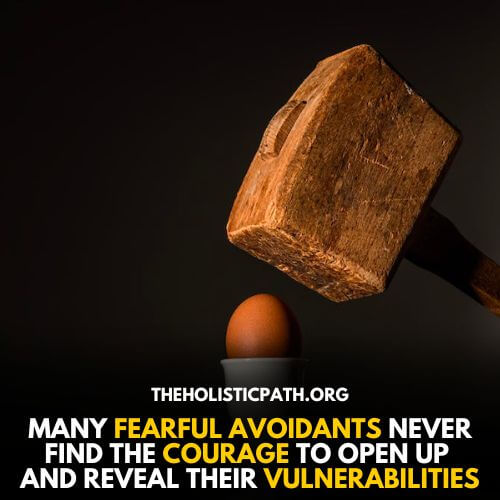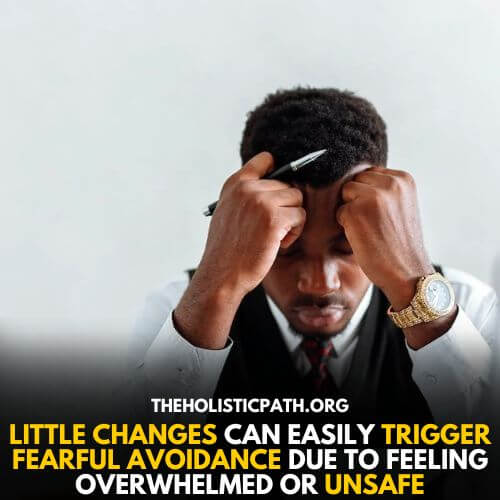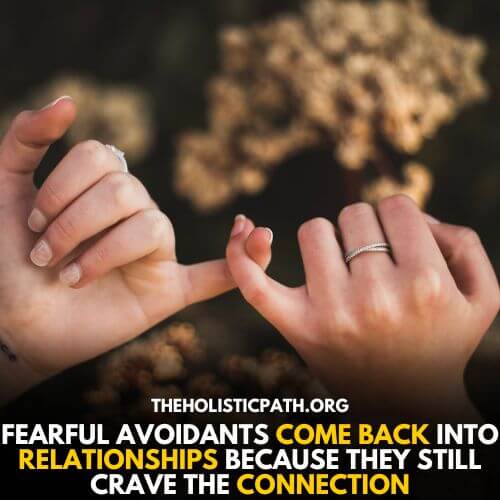It’s natural to feel afraid at times. Fear can help keep us safe, but it can also hold us back when it keeps us from making progress. The fearful-avoidant triggers that we often encounter in our lives can stop us from taking action. There are many things that can trigger fearful avoidant attachment style individuals. These triggers can be anything from a partner wanting to become closer, to feeling rejected or even just feeling like they are not good enough.
Fearful avoidant attachment style individuals often have a deep fear of intimacy and being close to others. This can make it difficult for them to form relationships and can also lead to feelings of anxiety and depression. It is important to understand fearful avoidant triggers so that they can be managed in a healthy way.
In this article, you’ll learn all about fearful-avoidant triggers and how to overcome them. We’ll take a look at what fearful avoidant triggers are, their common forms, and tips for managing them in a way that will ultimately open new doors and bring success. So read on to learn more about fearful-avoidant triggers and how you can manage them.
What Meant By Fearful Avoidant
Fearful avoidant is a term used to describe someone who tends to experience high levels of anxiety and fear in their relationships. They may also avoid or stay away from close relationships as a way of managing these feelings. Fearful avoidant is often used interchangeably with terms like anxious attachment and avoidant personality disorder.
People who are fearful and avoidant tend to have a lot of anxiety about their relationships. They may worry that they will be rejected or abandoned by the people they care about. As a result, they may try to distance themselves from others or avoid close relationships altogether. This can make it difficult for them to form and maintain close connections with others.
Fearful avoidant attachment is thought to develop in childhood when a person does not receive adequate emotional support from their caregivers. Children who do not have a secure attachment to their parents may become fearful and avoidant as adults, struggling to form trusting relationships and feeling anxious in close relationships.
Fearful, avoidant individuals tend to mistrust others and often feel they cannot rely on those around them. They may try to protect themselves by avoiding close relationships or pushing people away. This can make it difficult for fearful avoidant people to build meaningful, supportive relationships with others.
15 Causes of Fearful Avoidant Attachment
- Unresolved Childhood Trauma: Fearful-avoidant individuals are more likely to have experienced unresolved childhood trauma, such as physical or emotional abuse, neglect, or abandonment. These experiences can lead to an inability to trust others and an intense fear of being rejected or judged by others.
- Poor Socialization Skills: Some fearful-avoidant individuals may not have developed good social skills during childhood due to a lack of parental guidance and interactions with peers. They may be fearful and anxious in social situations because they don’t know how to interact effectively with others.
- Complex/Ambiguous Emotions: Fearful avoidants often struggle with understanding their own emotions, which can make it difficult for them to cope with difficult situations. They may be fearful or anxious about expressing their emotions in a healthy way, which can lead to a fearful-avoidant pattern of behavior.
- Fear of Intimacy: Individuals who fear intimacy typically do so because they are afraid of being rejected or hurt in some way. This can manifest as intense fear and avoidance of romantic relationships, even when it is safe and healthy for them to engage in such relationships.
- High Levels of Distress: People who suffer from fearful-avoidant attachment often experience high levels of distress due to fears that their needs will not be met by others, leading them to pull away from social connections and become isolated from those around them.
- Poor Self-Image: Fearful-avoidant individuals may have a poor self-image, believing that they are unworthy of love or belonging. This can lead to further fear and avoidance of relationships because they do not want to be judged or rejected due to their perceived flaws.
- Anxiety Disorders: Those who suffer from fearful-avoidant attachment often also struggle with anxiety disorders such as panic disorder or social anxiety disorder, which can make it difficult for them to engage in social situations without feeling intense fear and discomfort.
- Stressful Life Events: Experiencing stressful life events, such as the death of a loved one, divorce, job loss or financial difficulties can trigger fearful-avoidance behavior. These events can make it difficult for fearful-avoidant individuals to trust others and open up to them, leading to further avoidance behavior.
- Negative Experiences with Attachment Figures: If fearful-avoidant individuals have had negative experiences with an attachment figure in the past, such as a parent or other caregiver, this can shape their view of relationships and lead them to fear intimacy and closeness.
- Lack of Emotional Regulation Skills: Fearful avoidants may not possess the skills needed to regulate their emotions effectively, which can lead to overwhelming feelings that they are unable to cope with appropriately and ultimately result in fearful avoidance behavior.
- Poor impulse control: Those with a fearful avoidant attachment may have difficulty controlling their impulses due to a lack of emotional regulation and self-control, which can lead them to become fearful and avoidant in relationships.
- Social isolation: People with fearful avoidant attachment often isolate themselves from social situations in an effort to protect themselves from potential rejection or hurtful experiences.
- Lack of trust: The lack of trust in relationships is closely connected to fearful avoidant attachment, as fearful individuals find it difficult to open up and put their faith in another person due to their past experiences.
- Need for control: Fearful individuals may have an excessive need to control their environment and the people they are in relationships with, leading to fearful and avoidant behaviors as a way of protecting themselves from potential hurtful experiences.
- Defensive behavior: Those with a fearful avoidant attachment may develop a defensive behavior towards relationships which can lead to them avoiding intimacy or being fearful of getting close to someone.
Examples Of Fearful Avoidant
Fearful avoidant attachment styles are characterized by fearful attitudes and behaviors in close relationships. People with fearful avoidant attachment styles often avoid intimacy, closeness, and commitment due to fear of being rejected or hurt. They also tend to be insecurely attached and have difficulty trusting their partners.

Examples of fearful avoidant characteristics include:
- Having an intense need for independence and distance while at the same time longing for closeness and security.
- Trying to keep a partner at an emotional distance while still craving contact with them.
- Being overly self-reliant in order to protect themselves from potential rejection or abandonment.
- Becoming overwhelmed by feelings of vulnerability when confronted with intimate conversations or activities.
- Becoming fearful or anxious when their needs for closeness and security are not being met.
- Having difficulty trusting a partner due to fear of betrayal or abandonment.
Examples of fearful avoidants include:
- Someone who runs away from commitment or intimacy in relationships; may have difficulty expressing feelings openly or communicating their needs to a partner due to the fear of being judged or rejected.
- A person who avoids discussing personal issues in order to distance themselves from potential hurt or pain; may also find it difficult to ask for help even when needed, as they don’t want to appear weak.
- A person who is constantly testing their partner’s love and commitment, fearful that they will be abandoned if they let their guard down; may manifest in behaviors such as being needy, clingy, or always needing reassurance.
The fearful-avoidant attachment style is often rooted in childhood experiences, such as growing up with unreliable caregivers who were unavailable for emotional support. As adults, fearful avoidants may struggle with intimacy and trust in relationships, leading to feelings of insecurity and isolation.
14 Top Fearful Avoidant Triggers
Are you fearful of getting too close to people? Do everyday social interactions bring on anxiety and dread? If this applies to you, then you might have a fearful avoidant attachment. But what exactly are the triggers? Here, we take a look at 14 fearful avoidant triggers that might be affecting your life and relationships:
1. Rejection:
Rejection can be a fearful avoidant trigger, as it causes the person to feel fearful and anxious. This fear of rejection is often due to feeling like they are not good enough or that they don’t measure up in some way. People may also fear being judged or criticized based on their looks or performance, which can make them feel even more vulnerable to rejection.
As a result, fearful avoidants tend to engage in behaviors such as withdrawing from social situations or avoiding any kind of interaction that could potentially lead to rejection. They may also have difficulty forming relationships with others, as they struggle to open up due to fearful feelings of being judged and ultimately rejected.
Fearful avoidants may also suffer from intense feelings of loneliness and isolation due to their fear of rejection. They may not feel comfortable talking about their feelings or asking for help from others, and as a result, they can become even more isolated. This further increases the fearful avoidant’s risk of feeling rejected, which in turn leads to more anxiety and fear.
It is important to note that fearful avoidants are capable of forming relationships with others; however, it is often difficult for them due to the intense fear of being judged and ultimately rejected.
2. Negativity:
Negativity can be a fearful avoidant trigger for sure. Fearful avoidants may feel like it’s not worth trying to achieve anything because something bad could happen anyway – and that fear can cause them to shy away from activities and even relationships.
Also, fearful avoidants can become fearful of negative outcomes in any situation, like feeling as though their efforts will go unnoticed or unappreciated. Unfortunately, this mental roadblock often stops them from seizing opportunities in life and forming meaningful connections.
It’s a serious problem and needs to be addressed proactively so the fearful avoidants can overcome the underlying issues preventing them from building the life they want.
3. Conflict:
For fearful avoidants, the mere thought of a conflict is a fearful trigger. All they know is to retreat – to back away and not risk exposing their feelings and opinions. This can become a self-perpetuating cycle; fearful avoidants remain isolated, preventing them from forming meaningful relationships due to their fear of conflict.
In turn, this leads to even more trepidation and uncertainty around any type of disagreement, big or small. But learning to understand that conflict can be just as productive as it is stressful can help fearful avoidants build better communication by better understanding each other’s perspectives.
With that in mind, fearful avoidant triggers no longer have to create such fear, but rather an opportunity for growth.
4. Shame:
Shame is a fearful avoidant trigger, which is an emotional response driven by anxiety to actual or perceived danger or threats. As fearful avoidants take in their environment, they scan for potential triggers, and shame can be a big one. It is normal to feel embarrassed or ashamed in certain situations, but fearful avoidants may sense this feeling more intensely and are more likely to respond with fear and avoidance.
Unfortunately, when fearful avoidants withdraw from social situations due to feelings of shame, it can make it even harder for them to form meaningful connections and experience true intimacy in their relationships. Fortunately, there are treatment options available that have been proven to help fearful individuals manage their triggers and develop healthy coping mechanisms that allow them to move past their fear-based avoidance patterns.
5. Inadequacy:
Being fearful and avoidant can be one of the toughest things to grapple with, and the triggers that cause such feelings can be complex and varied. One of the biggest fears people in this category often face is an overwhelming sense of inadequacy – a conviction that they simply don’t measure up and don’t belong among certain social circles or groups.
This feeling of inadequacy may stem from a range of sources, including low self-esteem or an inability to please those around them, family, friends, or colleagues. In these situations, it’s important to try and stay aware of your emotions and reactions, as fearful avoidants often will try to escape difficult social environments by withdrawing completely or pushing away those around them.
6. Control:
For fearful avoidants, the fear of losing control can be a powerful motivator and may serve as one of their primary triggers. This fear can lead fearful avoidants to shy away from taking risks or situations where they may not have the upper hand. This tendency to avoid such experiences often results in difficulty fostering relationships with others, in turn making it hard to build trust.
It’s important to be aware of fearful avoidant triggers so that we can address them and pursue relationships with greater understanding and sensitivity toward those who struggle with similar feelings of discomfort.
7. Abandonment:
People with fearful avoidant attachment styles can often struggle with a fear of abandonment. This fear has the potential to be incredibly difficult and even debilitating, as it can cause fearful avoidants to become overly clingy, fearful of being left behind, or fearful of forming close connections with other people.
It’s important to remember that fearful avoidants are reacting out of self-protection rather than a desire for codependency or unrealistic expectations; this deeper understanding can help us all as we strive for healthy relationships.

Unfortunately, many fearful avoidants never find the courage to open up and reveal their vulnerabilities, instead choosing to hide from possible hurt and disappointment through painful (but necessary) patterns such as avoidance. No matter the situation, it’s always essential to regard fearful-avoidant triggers from a place of compassion and understanding.
8. Criticism:
Learning to handle criticism is a skill that can be difficult to master, especially if you identify with fearful avoidant traits. For those with fearful avoidance, criticism is like a fear trigger: it’s seen as an attack on their worth and it can cause them to feel embarrassed, hurt, and scared.
They may become fearful of taking risks, making mistakes, or trying anything new in the fear of being criticized again.
This can have a long-term effect on their sense of self-worth and make things like changing jobs or talking to new people very intimidating. It’s important for people with fearful avoidant traits to remember that it’s okay to make mistakes, and most constructive criticism should be seen as an opportunity for growth, not an attack on your character.
9. Judgment:
Making social connections and developing relationships can be daunting for fearful avoidants. This becomes especially hard due to fearful avoidant triggers such as judgment by others. Fearful avoidants worry constantly about being judged or scrutinized, which causes intense anxiety in social interactions since they believe that anything they do will be subject to external judgment and critical evaluation.
This judgemental fear is a major barrier to forming meaningful relationships and creates an immense burden for fearful avoidants who are trying to break through their shell but fear being judged for any action or decision. It’s important for fearful avoidants to recognize this fearful judgment as a trigger so that it won’t prevent them from reaching out and connecting with others in meaningful ways.
10. Failure:
Being fearful and avoidant can be a tough battle to fight. Sometimes this fear can show itself in fearful avoidants by making them worry that they will fail at anything they attempt.
This lands like a cloud of doubt over their head, spilling out into many aspects of their life.
They may feel fearful of taking risks or trying new experiences because they are worried that it won’t turn out in their favor, causing them to sit back and second-guess themselves instead. This lack of self-confidence may also prevent growth and development, which is a shame; fearful avoidants have so much potential if only they could access it!
11. Performance Pressure:
For fearful avoidants, feeling the pressure to perform in everyday life can be an incredibly nerve-wracking experience. Whether it’s attending a work meeting or going out with friends, this sense of performance pressure can lead to fearful avoidant reactions like worrying about impressing others, or not meeting expectations.
Ultimately, this can cause fearful avoidants to become overwhelmed by anxiety and fearful avoidance behaviors as a way of self-protection, ultimately resulting in them avoiding certain sorts of situations altogether. Understanding that this fear is very real and could be triggered at any time is an important step in learning how to cope with fearful avoidance reactions.
12. Changes in Routine:
Changes in routine can be incredibly challenging for fearful avoidant individuals as it often creates an uncomfortable level of unfamiliarity and disruption. Little changes such as the introduction of a new family member or starting a new job can easily trigger fearful avoidance due to feeling overwhelmed or unsafe.

To reduce fearful avoidant triggers, it is important to establish predictable routines from the get-go and to be mindful of any disruptions that may arise. Awareness of these triggers allows fearful avoidance behaviors to be anticipated and managed accordingly with patience, support, and understanding.
13. Intrusion:
Intrusion can be one of the most fearful avoidant triggers. When someone is trying to pry into our personal lives or pressuring us to do things we don’t want to, our natural tendency as fearful avoidants are to retreat and protect ourselves from feeling exposed. We don’t want to feel like we’re being controlled or manipulated, so it’s understandable that this type of intrusion leads to stress and anxiety.
It can also cause us to shut down emotionally, as we withdraw further into our protective shells.
It’s important for fearful avoidant individuals to recognize these warning signs when they come up so that they can take steps to prevent a full-blown meltdown.
14. Loud Noises:
Being triggered by loud noises is unfortunately a common aversion fearful avoidants must overcome. From the sound of a car horn to thunder and lightning, even everyday normality can be an irritant to fearful-avoidant individuals, who may find these sounds to evoke feelings of anxiety and distress.
As such, they may actively seek out quieter settings in order to feel more at ease. Furthermore, fearful avoidants are often startled by sudden changes in sound levels or other unexpected noises; this heightened sensitivity to sound can lead fearful avoidants to go out of their way to anticipate and control their environment for fear of affecting their physical and mental states.
By understanding fearful avoidant triggers and looking to address these issues, individuals can better manage their fearful avoidant tendencies and strive for a healthier, more fulfilling life.
What Attracts A Fearful Avoidant
- Intimacy: A fearful avoidant is typically attracted to an intimate connection with someone who they feel safe and secure with. This individual is often looking for a close relationship in which both parties can be open and honest about their feelings, thoughts, and desires.
- Affection: Fearful avoidants are usually drawn to someone who shows them affection, care, and understanding. These individuals also tend to be attracted to people who are willing to support them through difficult times, listen without judgment or criticism, and provide emotional safety.
- Compassion: People with a fearful avoidant attachment style tend to be attracted to those who demonstrate compassion towards them and view them without labels or assumptions. They appreciate those who can accept all aspects of their personality and want to connect on a deeper level than just physical attraction.
- Dependability: Fearful avoidants are often looking for someone they can rely on when they need it most – someone who will stick by their side through thick and thin. They seek out individuals that can provide stability in their lives as well as consistent communication which makes them feel secure within the relationship.
- Respect: Respect is another key factor that attracts fearful avoidants in relationships – they seek out partners that will respect their boundaries while still showing affection and understanding towards each other. Individuals with this attachment style value honesty above all else and expect their partners to show respect for their opinions even if they disagree on certain issues.
Why Fearful Avoidants Come Back
Fearful avoidants are emotionally sensitive, often fearful individuals that tend to distance themselves from relationships, particularly intimate ones. When a fearful avoidant starts feeling strong triggers of fear and anxiety, suddenly the comfort of their detachment begins to look less appealing.
This is why it’s not uncommon for fearful avoidants to come back – when they’re met with an environment and circumstances that feel more manageable or secure than what they left behind, they will often find themselves drawn back in. It could be a former partner they still care about, or just a comfortable reminder of the secure relationships they have been able to establish in the past – whatever it is, fearful avoidants can’t stay away forever.
Here are a few reasons why they come back:
- Fearful avoidants tend to come back into relationships because, even though they are fearful of attachment and closeness, they still crave it.
- They may find that their need for connection becomes too powerful to resist and so they choose to return in the hope of finding a secure bond.
- The fearful avoidant’s deep-rooted fear of intimacy may cause them to struggle in relationships, as they find it difficult to open up and trust.
- They may feel that the only way to cope is by creating distance, but then they feel a longing for connection, leading them to come back.
- Fearful avoidants will often return cautiously, so it may take time for them to rebuild trust and establish a secure connection.
- It is important to be understanding with fearful avoidants, as they are in need of reassurance and security in order to fully come back into the relationship.
- With patience, communication, and understanding, it is possible for fearful avoidants to form healthy relationships and learn to trust and open up.

Overall, fearful avoidants come back into relationships because they still crave the connection, even though their fear of intimacy is holding them back. With patience and understanding from their partner, fearful avoidants can learn to feel secure in the relationship and reconnect again.
Conclusion
Fearful-avoidant regret is tough to deal with because it can be triggered by so many things. It’s important to be aware of your triggers and try to avoid them as much as possible. If you do find yourself in a situation where you’re feeling fearful and avoidant regret, try to take a step back and assess the situation. Don’t let your emotions get the best of you and make a decision you’ll regret later.
References
Pietromonaco, P. R., & Feldman Barrett, L. (2006). What can you do for me?: Attachment style and motives underlying esteem for partners. Journal of Research in Personality, 40(3), 313–338. https://doi.org/10.1016/j.jrp.2005.01.003
What Is Fearful Avoidant Attachment? (2022, February 4). Verywell Mind. https://www.verywellmind.com/what-is-fearful-avoidant-attachment-5207986
